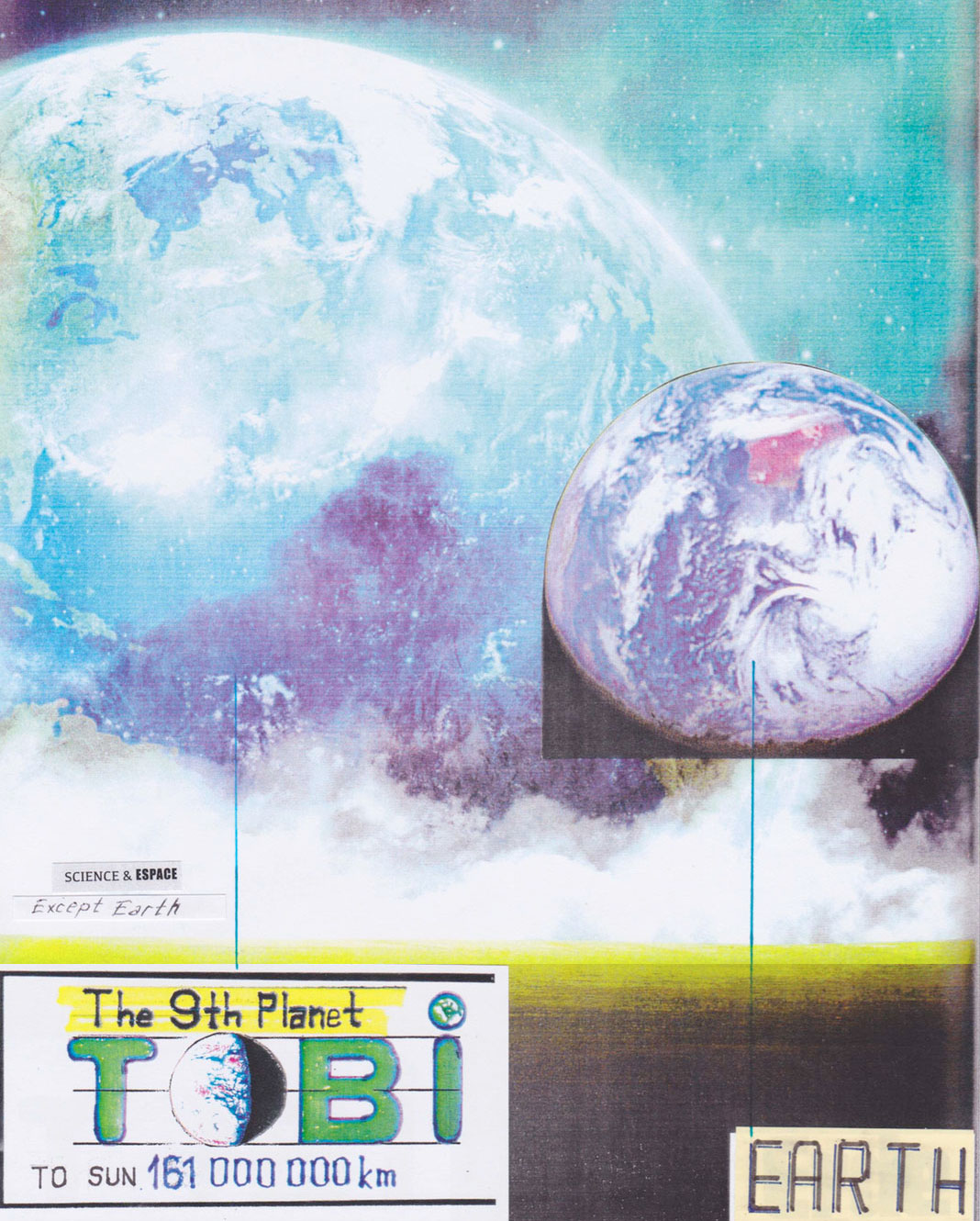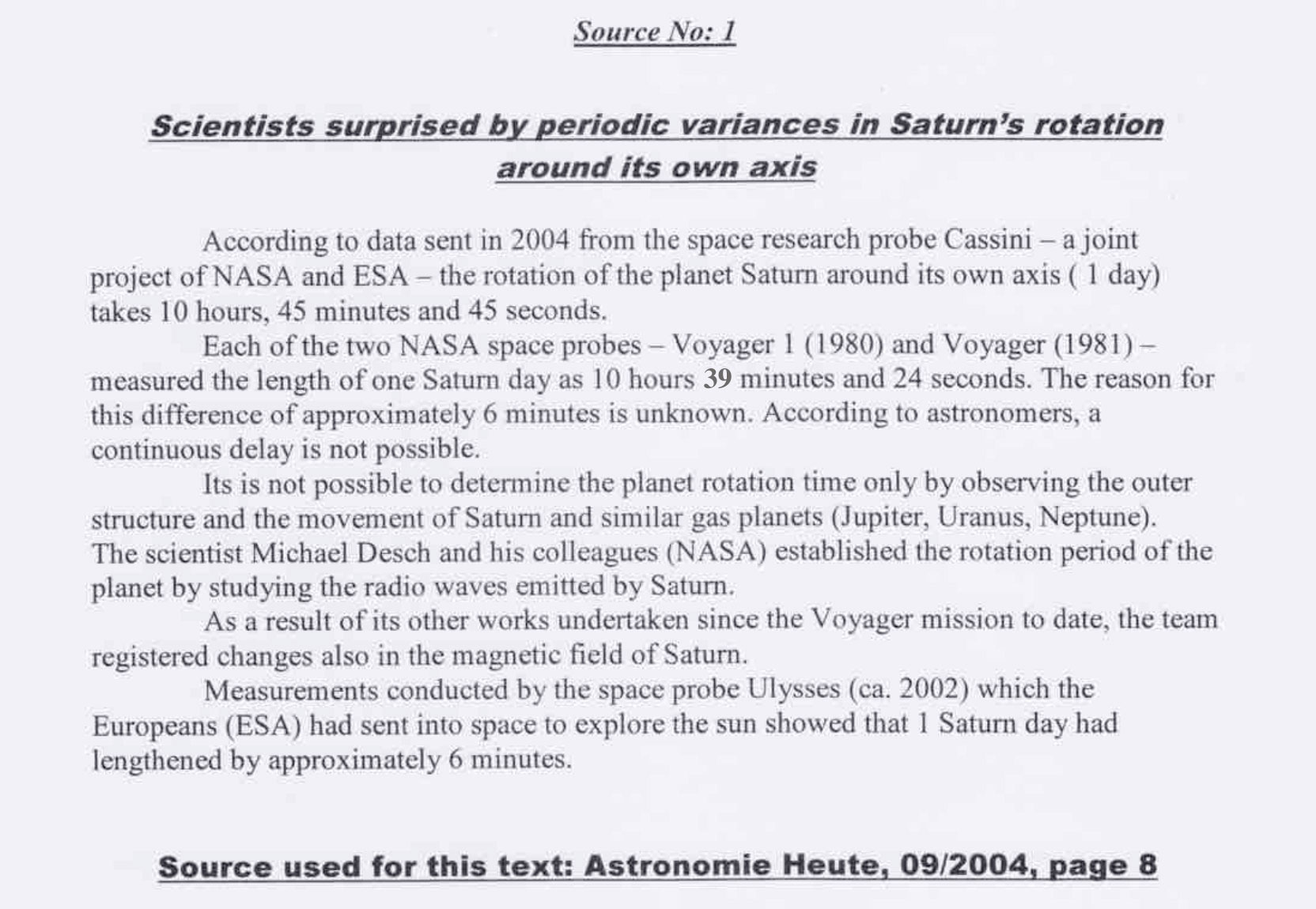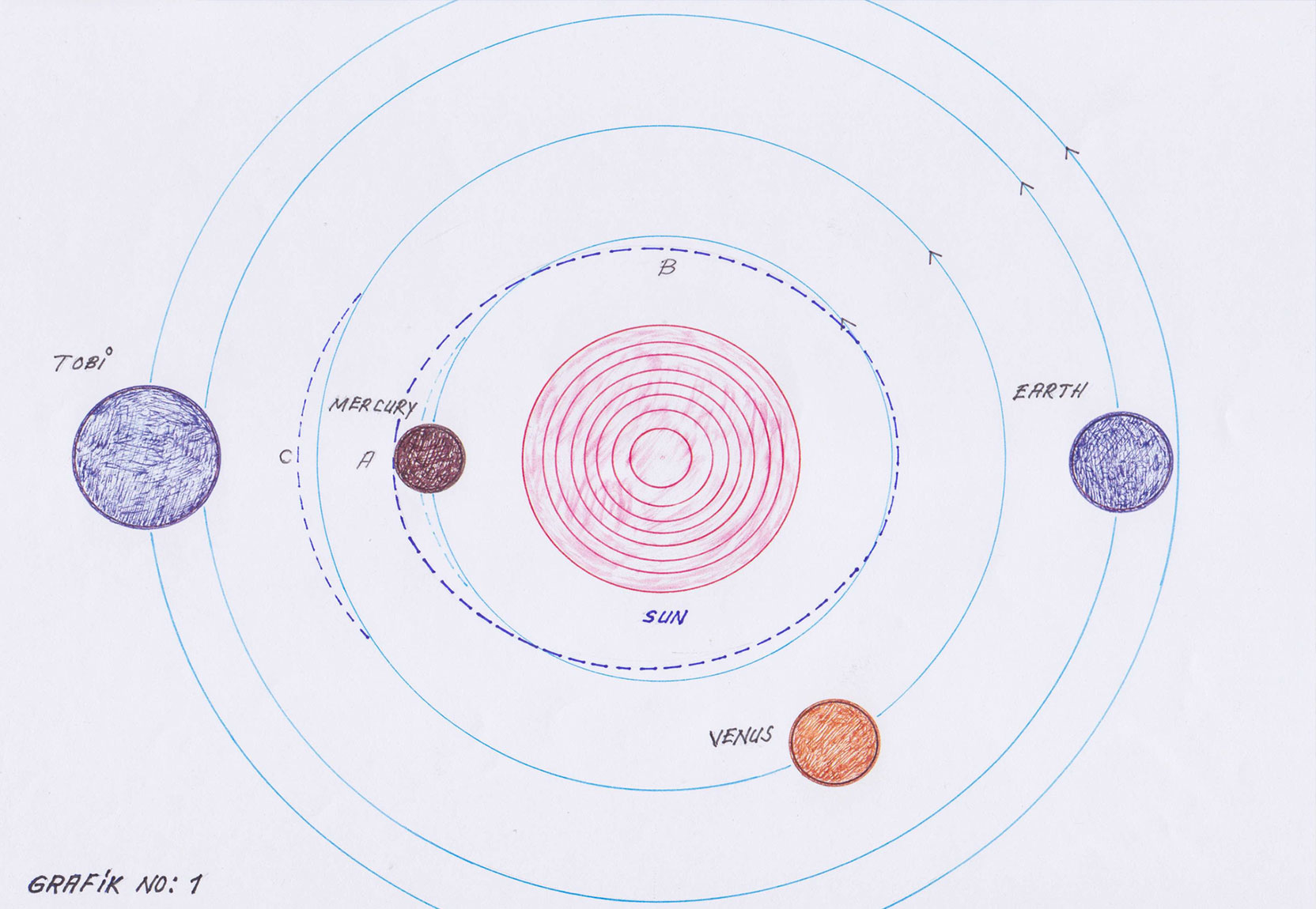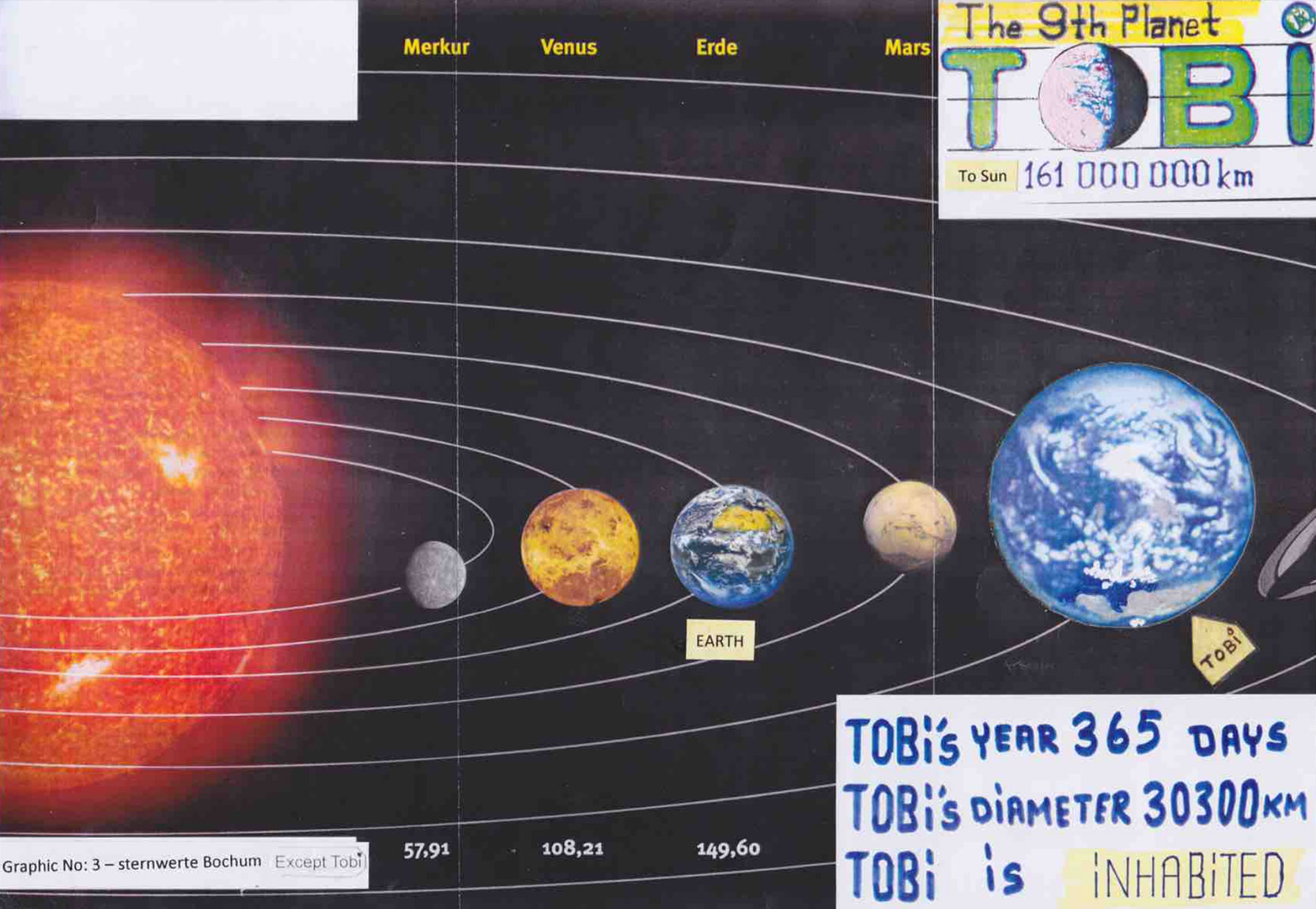Halis Altunsoy - theory of the 9th planet


My name is Halis Altunsoy, born in Turkey 1947. I live in Cologne/Germany since 1973 and work as taxi driver.
Since 40 years I am occupied with Astronomy-Geology and Philosophy.
Imprint
Dear ladies and gentleman!
On this page I am presenting you documents and information on a truth, or to say the least, on a discovery which is hard to believe. Everything began in september 2004 with news which I read in a journal about astronomy I am subscribed to.

A brief description of the news: Cassini, a planet survey or which arrived Saturn in 2004, began to measure Satum’s rotation speed (Saturn day). The result of its survey: 10 hours 45 minutes 45 seconds.
Now 24 years back, i.e. in the year 1980 the space probes Voyager 1 and Voyager 2 had done the same thing. They had resulted in: 10 hours 39 minutes 24 seconds. A difference of more than 6 minutes. In other words, Satum’s rotation has slowed until the year 2004, when we compare it with its rotation speed from 1980. And a Saturn day has become longer now. Only a planet, a big planet is mighty enough to slow down the rotation of a giant such as Saturn (diameter = 120.535 km, and the earth = 12.756 km) and extend its day by 6 minutes.
Enlighten by this fact, I rolled my sleeves up and began to seek this planet. The first suspect was the planet Jupiter. Saturn’s neighbor, and with its 142.984 km diameter a colossus in real terms. It completes on revolution around the sun (l year) on 11.9 earth years. The distance between the collateral orbits of Saturn, who revolves around the sun only once until the earth completes 29.4 revolutions, and Jupiter is 648 million km. So, interference is a must for both of them, when these two planets meet each other in their orbits.
At first, the distance of 648 million km between the two orbits seemed to be to much to me. And I started to search for answer. I asked to myself, whether another planet might be reason. The most mysterious region is the inner part of our solar system. Mars looks like an abandoned planet. One can deduce from the photos that it breeds water under the ground, and above the ground as well. But it lacks two things which are essential in our life: an atmosphere and a magnetic field.

Venus is a full secret. A Venus day is longer than a Venus year. One Venus day is equal to 243 earth days, and a Venus year to 225 days n earth. The surface temperature is about 500°C. The angle of the rotation slope is 178° the planet looks like a celestial body who tours in upside down position. An additional peculiarity of this planet: lt rotates in the opposite direction. This means, the sun rises in the west and disappears in the east. Its about 108 million km away from the sun. With its 12.104 km diameter Venus looks a twin sister of the earth.
Mercury is the smallest planet of solar system. The distance of the sun is 58 Million km, the diameter is 4.880 km. One year is 88 and one day is equal to 58 earth days. The Surface Temperature is during the day 430°C and nights is under 173°C. Free of atmosphere and magnetic field.
Mercury’s most remarkable feature is the rate of eccentricity: This rate increases if the oblateness rate of the revolution ellipsoid of a planet is higher. Less oblate a planet revolves, lower is its eccentricity rate (the eccentricity rate of a circle is equal to zero). Mercury revolves on a highly oblate ellipsoid, it is almost abnormal, aberrant. An example: The eccentricity rate of the earth is 0.0167, and that of Mercury 0.206. This is a big difference. The eccentricity rate of the mini-planet Pluto is 0.249. The graphic reveals the extremely big and elliptic orbit of Pluto. One would think, Mercury’s orbit must have the smallest eccentricity rate. And it’s a remarkable fact worth of questioning why Mercury has an orbit similar to that of Pluto.
Also Venus deviant revolution features resemble that of Mercury’s. What is the reason for these irregularities? The answer is: A planet located face to face with the earth at the opposite side of the sun, not smaller than the earth, exerts gravitational influence on Mercury and Venus, as it passes by. It attracts them. Mercury is more affected by the gravity of this planet since it’s the smallest planet of our solar system. It revolves in an extremely oblate orbit. And the fact that a day on Venus is longer than a Venus year can be traced back to the gravity force of this planet. Venus rotation is apparently being slowed down by this planets gravity force. This shows that Venus is very close to this planet in its orbit. Mars is being affected by this planet as well, even it’s not so much.

And why haven’t we been able to observe this planet up to now? The answer of this question is: Just like the earth, this planet revolves around the sun in 365 days. And due to this, it remains always behind the sun for our planet.
A second, important characteristic of Mercury concerns its perihelion point. As the planets revolve around the sun in elliptical orbits, they are situated at two points at a time during the revolution, at which they are the closest to the sun or most distant respectively. The orbit point closest to the sun is called the perihelion and that most distant to the sun the aphelion. The position of these two points remains the same in every yearly tour around the sun. Mercury’s perihelion, however, alters continuously. One has never seen it revolving though the same perihelion an aphelion.
Asimow “Guide to science” Turkish: Asimow Bilim Rehberi (page 512-514)
When we compare Mercury’s orbit to a necklace with a chain of tiny pearls, its perihelion slides from one pearl to the next, as Mercury begins its next tour around the sun. And its aphelion slips likewise with every revolution. In his book Asimow says that this slips of the perihelion adds up to a curve of 43” sec within 100 years. And in 4000 years the slipping of the perihelion brings about a diameter as wide as the moon (3474 km).
The same applies to Venus as well. According to the figures announced in 1960, scientists have measured an 8” sec difference in its curve within a period of 100 years. What these discoveries show: A rotation year of the above mentioned, yet unknown planet behind the sun, which always remains face to face with our earth, deviation, the perihelion and the aphelion slip gradually and continuously.
The fact the earth keeps on soothing on its way in the internal solar system, which looks like a zone for ghosts to wander about, indicates that there is a planet right across, situated right behind the sun.
I call this planet “TOBI”. (December 2012)
PS: Jupiter and Saturn come close to each other in approx. every 20 years, as they revolve around the sun. And they influence each others orbital and rotational speed. After the discovery of Tobi about 6 months passed. This was mid of 2013. Apart from the magazines which I thoroughly read, I did not read any other publication. Frankly spoken after having reached my goal after eight years of effort, I felt being feed to a high degree and I lifted my mind to holidays for an indefinite period. Also, I needed some time to grasp an process great discovery.
This was until I skimmed through books in a bookstore that I used to visit often, and where I found a book entitled “Ancient Egypt”. Ancient Egypt reminds me always the first on the Pyramids of Giza. I have always been greatly interested in the pyramids. Particularly from the of ancient technology. How did they make it technically to build such great monuments? What was the background of all this? How and from where Egyptians managed to bring there such big quantities of stone blocks?

When I read books on pyramids, I was interested first in their base dimensions. Whatever the reason, until today I have not found any information on this topic. After I bought some books, I parked my taxi at a quiet place for taxis, and after about 10 minutes I got brings eyes... The plan I had been looking for, was just open in front of me! Although there were no dimensions noted, I could already see that the plan was drawn according to a scale. Above that the plan contained transverse axes from one comer to the other corner of the pyramids.

First I increased the size of the plan that was 6x4 cm by the help of a photocopy unit and also made some extra copies. The picture shows two of the pyramids (Cheops and Kefren) which look as if they had a common axis. This third pyramid, the smaller Mikerinos, has its own axis, which clearly shows that it is separated from the others.
After I traced the axes, the first surprise occurred. There was no common axis. In addition, there was an angle between the axes. According to the axis of the central pyramid (Kefren) the other axes were placed on its right and left side.
The Cheops, the largest of the pyramids of Giza, is in the background a the photo (see photo of pyramides above). This pyramid was originally 147 meters high. Today, it is only 144.7 meters high. Although the Kefren, which can be seen in the center, is 0.7 meter lower‚ it Iooks higher. The reason for this is that it was built on a higher platform. When I measured the angle that is formed by the axis of the central pyramid and by the other two axes, I became awestruck. Both angles were about 3.5°. At this moment I was forced to think of the angle of the earth rotation, which is 235°, and also of the planet Tobi. The middle pyramid represented the sun. This thought made me grow stiff, and at the same moment I was trapped mixed in fear and kind of doubt feeling, because of worry that my reasoning might not be correct. So I draw the minor axes which are at an angle of 90° to the major axis, and measured their distance between earth and the Sun, which is 147 million kilometers(*) is on the plan 53mm. The distance between Tobi and sun is 58mm.
(*) The distance between earth and sun varies from 147 to 152 one million kilometers. It is obvious that the original height of the pyramid of Cheops 147 with meters represents this distance.

I divided the 147 million kilometers by 52 and multiplied the result 2.77 (without zeros) with 58. The results is 160867. So 161 million kilometers. This number represents the distance between Tobi and the sun. Using the same method, I divided the diameter of the earth, which is 12756 km, through 16, according to the mm, which is on the plan the diameter of the earth, and thus came to the number 797.25 (km). I multiplied the number 38 (mm), which is the diameter of Tobi on the plan, with 797.25 and thus obtained the number 30295.5 (km). As a result, Tobi with a diameter of 30295.5 km and its big volume is 14 times larger than the earth and thus represents a giant planet (*).
On map no. l the distance from the sun axis to the center of Tobi is shown with 3 mm. The earth’s axis is 13 mm. If we add these numbers we have 3 + l 3 : 1 6 mm . On the same plan the diameter of the earth is represented by 16 mm. If we express this in numbers: 12756:16 = 797,25 (km)
797.25 x 3=2391.75 km (the distance between the center of Tobi and the sun axis) 797,25 x 13=10364.25 km (the real distance between the earth’s axis and the center of the sun). Added together: 2391.75 + 10364.25:12756km. Exactly the length of the diameter of the earth. This stunning result purely effects exclaim “WOW”.
After the addition of the distances between the axis of Tobi and the center of the sun and the distance between the earths axis and the center of the sun was found exactly to be the diameter of the earth, I felt an indescribable happy feeling. Comparable to “kill two birds with one stone catch”. Thus the wonderful creatures that live on Tobi and the existence of the planet Tobi were proven for the second time. The solution of the mysteries of the pyramids turned out to be a byproduct in comparison to this great perspective.

When I was dealing with the drawings, I often had a make measurements. After I checked the edge lengths of the pyramids, I had another surprise: The adjacent edges have different lengths. This was the case with all three pyramids. This shows to be reasonable because the polar regions of the sun, Tobi and the earth are flat and the equator regions are curved. For instance, the diameter of the earth between the two polar regions and the diameter of the earth in the equatorial zone have a length difference of about 43 km. This Situation also applies to the sun and Tobi.
This result seemed to me “like icing on the cake”. I now understand why Egyptian scientists did not divulge the dimensions of the edge lengths. They considered the different edge lengths certainly asamistake.
What hast to be done: a planetary research unit should be constructed by the support of the 40 richest countries in the world‐ and has to be brought into orbit, in the opposite(*) I’d like to mention that we have to expected here an error margin of l to 3%. Direction (*). On the left side of the unit a heart symbol should bepainted, and a coffee cup on the right side, from which coffee steam rises. The research unit would reach Tobi after about four months (**) and perform there the necessary measurements ‐ in a distance of about 12 million km and approximater 9 months (!) it will meet again the earth. I am sure that all the creatures living on Tobi will enjoy this visit very much.
For all parents the first steps of their child are very exciting. They always use to wait at a distance of two steps and are aware to catch the child with outstretched arms by expecting that the child makes the first independent step. I am sure that the inhabitants of Tobi are also excitedly waiting for us. I am sure that the nice and respectable owners of their planet will once land on earth, to drink a cup coffee with us.
After the secrets of the pyramids have been lifted, the distance between the sun and the planet Tobi was determined at about 161 million kilometers. The distance between the planet Tobi and the orbit of Saturn at about l billion 269 million kilometers. This is also found that the planet which disturbs the orbit of the Saturn every 20 years is the planet Jupiter. Or the fact that these giant planets effects each other. There is another influence: The orbit speed of all planets, when approaching the sun or the becomes a little bit slower.
When the planets move away from the perihelion point, the rotational speed is getting slower and the rotation of the axis becomes faster. When the speed of the rotation axis gets faster, the days are going to be shorter and vice versa, the days are getting longer. When the planets get nearer to sun and to the planet Tobi, their rotational speed becomes faster. By this the orbit gets shorter, or more acute. When the orbit speed becomes slower, the ellipse will be larger again. This means that the “happens” orbit becomes more narrow at the perihelion point (B) and widens at the aphelion point (A). From this view the sun represents the yolk ofthe egg.
With love and respect for all that is exiting!
Halis Altunsov
Cologne, June 21, 2014
(*) I have calculated the orbit of Tobi to an extent of 1.1 billon kilometers. The orbit between earth and Tobi is 550 million km.
(**) The holy creatures that live on Tobi will notice our activity no doubt before the research unit started.
P.S.: Turkish original text: (www.der-neunte-planet.de)